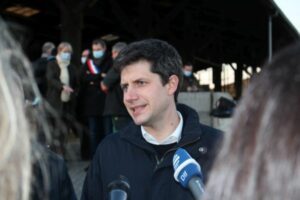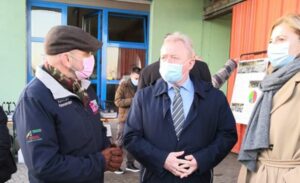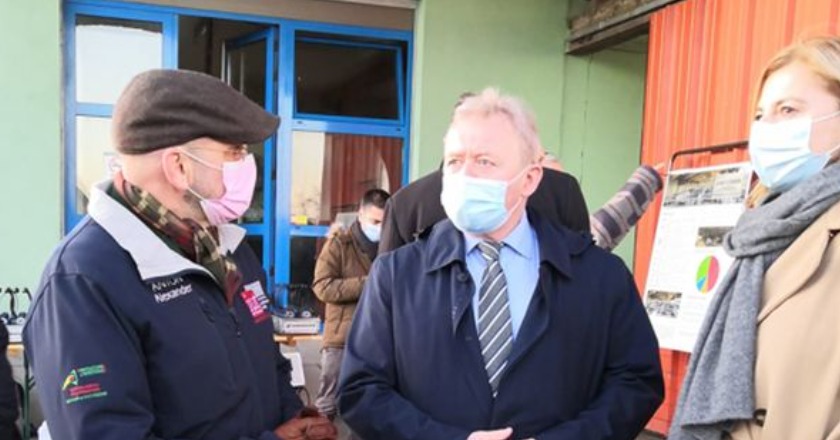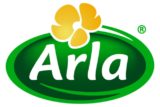Carbon farming is currently the hot topic in the political agenda of EU agriculture. The term refers to the agricultural practices enhancing the sequestration of atmospheric carbon and its storage in the soil.
Together with industrial and technological solutions to lower carbon emissions, carbon sequestration by European land will contribute to the achievement of the EU climate goals.
“While carbon stockage in trees and forests are often top of mind, the by far largest stockage capacity is in the sea and in the soil and hence in agriculture and farming – the farmers are true climate soldiers”, highlighted French agricultural minister Julien Denormandie.

French farm minister Julien Denormandie at a dairy farm visit in February 2022
Last December, the European Commission presented its plans to scale up carbon farming to remove CO2 from the atmosphere. A regulatory framework for the certification of carbon removals will be implemented to achieve the objective.
The idea is to introduce a new business model in which farmers as land managers are rewarded for the climate friendly practices they implement, enhancing the carbon sequestration potential of European land and contributing to the EU climate neutrality target.
During an informal meeting organised by the French presidency of the EU Council in February, the 27 national EU agriculture ministers and EU Commissioner for Agriculture Janusz Wojciechowski gathered in France to share their experience of climate-friendly farming and visit a concrete example of a low-carbon dairy farm.
Located in Haut-Rhin region in France, the GAEC Losser farm has invested in modern stables for the 160 cows that give 1.8 million litres of milk per year, around 11 000 litres/cow/year. The milk is collected by Alsace Lait, an independent dairy cooperative of 200 producers in the eastern part of France.
“Our farm is part of the “France Carbone Agri initiative, the French project aimed at reducing greenhouse gas emissions and increasing the carbon sequestration of farming activities, and uses France’s voluntary labelling system for low-carbon agriculture”, explained Alexis Losser, one of the owners of the farm, to the agricultural ministers.
A broader framework
This system is part of a broader framework launched by the French government in 2019 to encourage and finance emissions reduction projects in all sectors of the economy and has allowed to reduce greenhouse gas emissions on farms by around 20%. This means avoiding the production of between 350 and 500 tonnes of CO2 equivalent on farms over a five-year period. A multi criteria assessment tool is used to quantify the carbon balance and identify areas of improvement, allowing farmers to implement low carbon practices and avoid emissions, as well as increase the sequestration of atmospheric carbon. Such initiative provides the possibility to farmers to engage for lowering emission on-farm as part of a voluntary market-based compensation system.
On the margins of the informal Council meeting, French Minister Julien Denormandie said that the aim is to create a political momentum for highlighting and accelerating soil carbon sequestration.
The objective is to establish a EU framework for issuing carbon credits to reward the farmers for the carbon stockage of their soils and for the measures they take to improve the carbon sink qualities of their land.
While setting the right incentives, our carbon credits must be competitively priced – especially compared to carbon certificates in other parts of the world”, said Minister Denormandie.
A Commissioner’s view
EU Commissioner for Agriculture Janusz Wojciechowski welcomed this joint approach on low-carbon agriculture: “There is a strong alignment on the basic principle within the European Union, we now have to flesh out the details in a legislative proposal – and we’re committed to to publish our proposal on the certification of carbon removals by end 2022.”
EU Commissioner Janusz Wojciechoski underlined the contribution of agriculture to the climate targets and highlighted the benefits that carbon farming practices can bring in terms of environmental and climate benefits, as well as in terms of agriculture productivity by increasing soil quality. He also stated that the increasing demand for carbon credits could represent an additional source of income for farmers. “This is a win-win-win situation, for the climate, for the quality of our soils and for the farming community in terms of better productivity and an opportunity for additional income.”

“Natural carbon sinks will play a key role in the transition towards a carbon neutral continent by 2050. And here, the carbon sequestration of dairy grassland can offset a significant volume of emissions. The Losser farm in France is just one of the many existing projects within the European lactosphere aimed at enhancing carbon sequestration. Developing reliable calculation methods and the right incentives is now the challenge when drafting the legislative proposal”, underlined EDA secretary general Alexander Anton.
As showed by Alexis Losser in his farm, the dairy sector is actively engaged in the fight against climate change and dairy pastureland offers an excellent opportunity due to its capacity to store carbon. And this is only part of our European dairy strategy: the goal of the dairy sector is to improve the overall environmental performance of dairy operations. Greenhouse gas emissions is, in fact, are only one indicator for environmental sustainability, and a more holistic approach is needed to ensure co-benefits are obtained on other environmental components such as biodiversity and water use. The European Dairy Product Environmental Footprint (PEF), approved by EU Commission and Members States in 2018 as the reference methodology for the dairy sector, represents the right tool for assessing the environmental performance of our products across a broad range of environmental indicators.



